
Many coifs ... used metal threads in plaited braid or chain stitches to work the stems, and a variety of detached buttonhole stitches to create fruit and flower motifs in relief. Today many people are captivated by the informality of such designs which mix flowers and fruit in seemingly incongruous combinations: the grape with the pea plant; a fomral lily with a humble pansy. To us a strange choice perhaps, but one which reflects the former importance and status of different plants. It has been suggested that the coiling stem is a descendent from Celtic design, most famously interpreted in Opus Anglicanum as the 'tree of Jesse'. It seems plausible that after the Reformation of the Church, professional embroiderers formerly providing ecclesiastical commissions should apply their designs, such as the fruiting vine, to secular uses. Similarly the appropriation of church vestments for domestic use may have helped to widen the popularity of formerly religious motifs."
The pictures and accompanying descriptions below were scanned and typed in by Karen Harris (Karen@agent.infodata.com) and are mostly taken from the book TREASURES FROM THE EMBROIDERER'S GUILD COLLECTION and EMBROIDERY 1600-1700: AT THE BURRELL COLLECTION

Linen worked with silk threads. The colors are unusually vivid and in places two different colored threads have been twisted together to give an intermediate shade. Various animals, including snakes, are included among the flowers. 25cm x 45cm.
Coifs were sometimes worn with a piece of triangular fabric stitched to the front with the point towards the back. These were called forehead loths and although their exact purpose is uncertain it is known that they were worn during illness. Fynnes Morrison wrote in 1617 that "Many weare such crosse-clothes or forehead clothes as our women use when they are sick." The tragic scene of "Sir Thomas Aston at his Wife's Deathbed," painted in 1635 by John Souch, shows Lady Aston, who died in childbirth, wearing a linen cap with a broad lace band covering her forehead. The more cheerful and charming painting of Sir Richard Saltonstall by the bedside of his wife who had recently given birth shows her with a linen cloth covering her forehead. This painting is attributed to David des Granges and is dated about 1638.
This coif, which still has its forehead cloth attached, dates from the early years of the 17th century. It is worked with roses, pansies, strawberries, borage and honeysuckle. The coif and forehead cloth were made separately and then stitched together.
English, early seventeenth century. Linen embroidered with a scrolling
pattern in silver-gilt thread, the flowers, animals and birds in varied
techniques including plaited braid, chain and detatched needlelace
stitches in silk with metal strip and spangles. The embroidery is highly
textural, the top layer of the peapod peels back to reveal golden peas,
and some of the flowers are worked over padding whilst others, and the
bees wings, are detatched.
Linen ground fabric embroidered
with silk and silver-gilt threads, silver strips and a few spangles. The
stems are worked in plaited chain, whilst the flowers are embroidered in
detatched lacework. The coif has been opened out to show the complete
embroidery design.
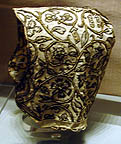
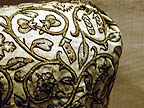
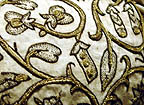 | A coif, early 17th c., worked in black silk and gilt thread in a variety of stitches. A thread would be passed through the loops at the bottom of the neck to gather the coif at the base of the neck. |

| English coif, early 17th century. A pattern of holly leaves in black silk and gilt on linen, with buttonhole stitching around the front edge. It's very similar to a coif listed below. |

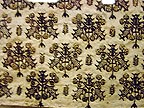 | c. 1600 coif at the V&A Museum. Black silk and couched gilt thread embroidered in a design of holly berries on a linen background, with buttonhole stitching around the front edge. |

| Late 16th Century Coif at the V&A Museum. Gilt thread and black silk in plaited braid, back, chain and double running stitch on fine white linen. Museum No T.11-1948 |

| Late 16th century coif at the V&A. Black silk and gold metal thread on white linen. Backstitch, chain stitch, buttonhole stitch and plaited stitch used, along with speckling. |

| An English coif, c. 1600, made from a rectangular panel of embroidery. Gilt thread and black silk in back, buttonhole and interlacing stitch on linen. |
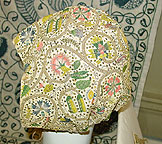
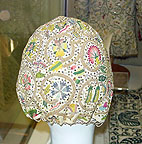
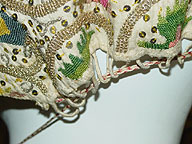
| A polychrome, silk-embroidered coif made of linen with gilt spangles. Currently on display at the Platt Museum in Manchester. |
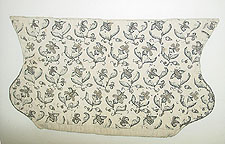
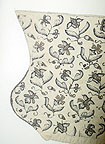
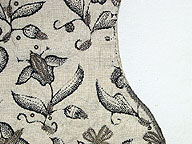
| A blackwork coif with silver gilt embroidery, currently at the Platt Museum in Manchester. |
